Services on Demand
Article
Indicators
Related links
-
 Cited by Google
Cited by Google -
 Similars in Google
Similars in Google
Share
South African Journal of Education
On-line version ISSN 2076-3433
Print version ISSN 0256-0100
S. Afr. j. educ. vol.29 n.1 Pretoria Feb. 2009
Perspectives of teachers on the implementation of Life Orientation in Grades R–11 from selected Western Cape schools
Karel van Deventer
Karel van Deventer is Senior Lecturer in the Department of Sport Science, Faculty of Education, Stellenbosch. He is a widely published researcher with a research emphasis on movement education
E-mail: kjvd@sun.ac.za
ABSTRACT
Educational transformation in South Africa not only brought about Outcomes- based Education and Curriculum 2005 but also a new Learning Area/Subject, called Life Orientation (LO). A major challenge for LO as a new Learning Area/Subject is the preconceptions that exist about it, and the fact that the attitude of school principals is not conducive to the successful implementation of LO. Against this background it was deemed necessary to investigate teachers' perspectives regarding the implementation of LO in Grades R to 11. For the survey 248 schools (124 primary, 124 secondary) were randomly selected, of which 157 returned questionnaires. Summary statistics were done using frequency tables and histograms. Comparisons of ordinal variables were performed using one-way analysis of variance and the Kruskal-Wallis non- parametric test. For the majority of the schools the learning outcomes, related to the movement component of LO in the General and Further Education and Training bands, are presented. The fact that most of the schools do not have qualified Physical Education teachers holds certain implications for the status of LO in general and more specifically for the growth and development of the learners. To address this situation it is recommended that in-service and pre- service education and training of teachers commences immediately and that Higher Education Institutions become more involved in different forms of training initiatives than currently the practice.
Keywords: Curriculum 2005; Further Education and Training Band; General Education and Training Band; Life Orientation; National Curriculum Statement; outcomes-based education; physical education; teacher training; teachers' perspectives.
Introduction
Curriculum 2005 (C2005) with its implementation in 1998 was regarded as the master plan to eradicate the inequalities of the apartheid education system. In 2000, C2005 was revised and is now referred to as the National Curriculum Statement (NCS) (Jansen, 1998; Manganyi, 2001; Harley & Wedekind 2004; Vambe, 2005). The NCS is an outcomes-based, integrated knowledge system based on a learner-centred pedagogy that has to improve the quality of education for all in South Africa (SA) (Jansen, 1998; Botha, 2002; Fiske & Ladd, 2004; Todd & Mason, 2005). However, the potential for Outcomes-based Education (OBE) to enhance learning in all South African schools, given the historical and situational constraints, is limited. Numerous schools in SA have been unsuccessful in implementing the concept of outcomes to drive the educational programmes and state resources have not been sufficient to bring all schools up to the standard that was enjoyed by former Model C schools prior to 1994 (Whitaker & Whitaker, 1995; Mathieson, 2001; Todd & Mason, 2005; Vambe, 2005). The main factors that hinder policy implementation in South African schools are the lack of management capacity and the scarcity of resources (Jansen, 1999; Botha, 2002; Fiske & Ladd, 2004; Prinsloo, 2007). Educational transformation not only brought about C2005 and OBE, but also a new Learning Area called Life Orientation (LO) in the General Education and Training (GET) Band (Grades R-9) and a new subject in the Further Education and Training (FET) Band (Grades 10-12). This new Learning Area/Subject is to equip learners with the skills, knowledge, attitudes and values (SKAV) to face life's challenges in an informed, confident and responsible way (DoE, 1997; Jansen, 1998; Botha, 2002; DoE, 2002a; DoE, 2002b; Fiske & Ladd, 2004; Hendricks, 2004; Vambe, 2005; Christiaans, 2006).
A major challenge for LO as a new Learning Area/Subject is the preconceptions that exist about the non-examinable status of its previous constituents, such as Guidance, Youth Preparedness, Religious Education and Physical Education (PE) (DoE, 2002b; Van Deventer, 2004; Rooth, 2005; DoE, 2008b). A major concern of Christiaans (2006) is that the attitude of school principals is not conducive to the successful implementation of LO. For example, it may be expected of a Guidance teacher to teach all aspects of LO or a PE teacher to offer the other aspects of LO that fall outside their realm of familiarity (Rooth, 2005:22). Irrespective of what the situation is, it seems that LO is taught by a broad spectrum of teachers that are not specialists in this field (Van Deventer, 2004; Rooth, 2005; Christiaans, 2006; Roux et al., 2008). According to Christiaans (2006), insufficient support from the Department of Education (DoE) does not improve the situation. The fact that LO is taught by teachers that are not LO specialists is an important aspect, since the epistemology and skills of the teachers who teach a learning area/subject determine the status and practice of that learning area/subject (Talbot, 2001; Hardman, 2003; Rooth, 2005; Christiaans, 2006).
The review committee for C2005 in 2000 noted that adequately prepared teachers who were motivated to teach and had the required support to do their work, form the basis of the successful implementation of an outcomes- based framework. The review committee found among other things that South African teachers were inadequately trained (DoE, 2000a). Botha (2002), Van Deventer (2004), Rooth (2005), Christiaans (2006), Prinsloo (2007), Roux et al. (2008) and Van Deventer and Van Niekerk (2008) came to the same conclusion as the review committee regarding inadequately trained LO teachers. Rooth (2005:237) purports that at a school where all teachers taught LO, pre-planned teaching packs were handed to teachers at the beginning of the year and irrespective of the learners' needs or interactions in class, teachers taught in a paint-by-numbers way. Teachers will resent having to teach LO if they are not knowledgeable about the content. Therefore, specialists in LO are needed (Rooth, 2005; Van Deventer, 2007; Van Deventer & Van Niekerk, 2008). Rooth (2005:238) purports that:
The danger is that if everybody teaches Life Orientation, nobody will teach it; it will be so integrated in other learning areas that it will be invisible.
Although many misconceptions about LO exist, it does seem that teachers and learners attribute considerable significance to LO (Rooth, 2005; Christiaans, 2006; Van der Walt & De Klerk, 2006; Van Deventer & Van Niekerk, 2008). Rooth (2005:22) believes that:
It would be a devastating loss of an educationally sound opportunity if Life Orientation could not fulfil its potential to make a vital contribution to learners' successful living, learning and well-being.
In the 21st century learners are faced with needs and challenges that offer both problems and possibilities. LO can address many of these needs and challenges that learners encounter (Hendricks, 2004; Rooth, 2005; Theron & Dalzell, 2006; Prinsloo, 2007). The significance of LO to the broader vision of education in SA is underscored by all the cardinal issues dealt with in LO (Rooth, 2005). According to the NCS (DoE, 2002b), the phrase LO contains what it intends to do and that is to guide and prepare learners for life and its possibilities. Furthermore, it equips learners for meaningful and successful living in a rapidly changing and transforming society. The focus of LO is life-in-society. The GET Band (Grades R-9) concerns itself with Health Promotion, Social Development, Personal Development, Physical Development and Movement and Orientation to the World of Work (DoE, 2002b). In the FET Band (Grades 10-12) the Learning Outcomes of LO are Personal Well-being, Citizenship Education, Recreation and Physical Well-being and Career and Career Choices (DoE, 2003a). Although the Learning Outcome Recreation and Physical Well-being is now known as Physical Education it does not mean that PE is now a fully-fledged subject in the FET Band. Physical Education is still a focus area of LO with the exception that 60 minutes a week should be allocated to PE on the school timetable in Grades 10-12 (DoE, 2008a).
From the literature review it is clear that LO within the context of curriculum transition, coupled with the legacy of its constituents, is fragmented and struggling to define itself (Rooth, 2005; Van der Walt & De Klerk, 2006).
Against this background it was deemed necessary to investigate the implementation of LO, not only because of an interest in PE, but also because LO as a Learning Area/Subject in the GET and FET band, respectively, is new. The fact that LO is a new Learning Area/Subject evokes a number of questions; not only the success of its implementation, but also its status amongst teachers?
Aim of the research
The main aim of the study was to determine the perspectives of LO teachers regarding the implementation of LO with specific reference to the Learning Outcome, Physical Development and Movement (PDM) in the GET Band, and the Learning Outcome, Physical Education (PE) in the FET Band in randomly selected primary and secondary schools in the Western Cape.
The following secondary aims were addressed:
o To determine teachers' perspectives regarding certain LO curriculum issues in the GET and FET Bands.
o To determine whether schools have qualified PE teachers to teach the Learning Outcomes, PDM and PE in the GET and FET Bands, respectively.
o To determine whether the LO teachers have in-service training needs.
o To determine whether the schools have sufficient and suitable facilities and equipment to present PDM and PE in the GET and FET Bands, respectively.
Methodology
Research design
Quantitative and qualitative data captured by a questionnaire typify the research design as a survey.
Sample
A pilot study was conducted during 2006 to determine the content validity of the self-designed questionnaire used to capture the data in the current study. The feedback received after the pilot study was used to modify the questionnaire. Schools in the Western Cape (N = 248 [primary n=124; secondary n = 124]) were randomly selected from an address list provided by the Western Cape Education Department (WCED). The sample population consisted of LO teachers in the selected schools. These teachers were decided upon to complete the questionnaires as possibly they had a more hands-on reflection. Of the randomly selected schools (N = 248), 157 responded which is a response rate of 63%. A further analysis of the responses indicated that 95 primary teachers (n = 50 Foundation Phase [FP]; n = 45 Intermediate Phase [IP]) and 62 secondary teachers (n = 30 Senior Phase [SP]; n = 32 FET) returned questionnaires. In the FET Band only Grades 10 and 11 were included in the sample because LO was introduced in Grade 10 in 2006, in Grade 11 in 2007 and only in 2008 in Grade 12.
Questionnaire
One questionnaire was used for the phases of the GET Band as well as for Grades 10 and 11. The only distinctions in the questionnaires were made where reference was made to a specific phase. The questionnaire consisted of four sections. The first related to demographic information which mostly focused on the school community. The main section of the questionnaire related to the curriculum in which various factors ranging from qualifications to the NCS were covered. The third section related to extra-mural activities with the focus on available facilities and extra-mural sporting activities presented at the schools. In the fourth section, teachers had to reflect on general issues related to major problems encountered with the implementation of LO.
Statistical calculation
Summary statistics were done using frequency tables and histograms. Cross tabulation and the Chi-square test were used to compare categorical data between the Foundation Phase (FP), Intermediate Phase (IP), and Senior Phase (SP) of the GET Band, as well as with Grades 10 and 11 of the FET Band. Comparisons of ordinal variables were done by using one-way analysis of variance (ANOVA) and the Kruskal-Wallis non-parametric test. Bonferonni multiple testing corrections were used. Statsoft Statistica 8.0 was used to analyse the data (STATSOFT, 2007). The level of significance used throughout the study was p < 0.05.
In the following sections, the data will be discussed as they relate to the FP, IP and SP, as well as Grades 10 and 11.
Discussion of results
Demographics of the study
Although a random sample of primary and high schools was selected in the Western Cape, the majority of responses (n = 101) came from schools that primarily served the coloured community, followed by the white (n = 44) and black (n = 12) communities. Although the location of the schools was mainly urban (n = 92), a fair number of schools were located in rural (n = 65) settings. The main religious denomination found in the schools was Christianity (99%). The size of the schools (n = 81) fell mostly in the range of 500 to 999 learners in total.
Curriculum information
Life Orientation was presented as a Learning Area in the GET Band (Grades R-9) and as a Subject in the FET Band (Grades 10 and 11) in 96% of the schools. Ninety-nine percent of the LO teachers were of the opinion that they understood the principles of OBE.
The results were compared to determine whether knowledge regarding the principles of OBE was obtained at departmental in-service training sessions or at Higher Education Institutions (HEIs). The researchers thought it necessary to determine who the role players were in the in-service education and training (INSET) of LO teachers and not the duration of the programmes or courses. As shown in Figure 1, it is clear that most LO teachers obtained their knowledge at departmental in-service training sessions when compared with Figure 2. No significant difference (p = 0.61) was found between the LO teachers of the FP, IP and SP in the GET Band and the LO teachers in the FET Band.
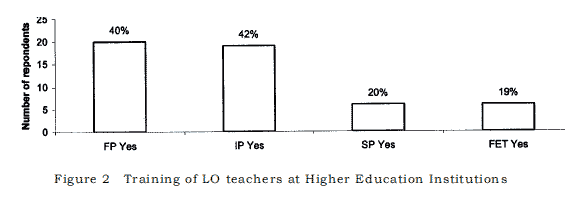
A significant difference (p = 0.04) regarding training at HEIs was found between the LO teachers of the FP, IP, SP and the FET Band. In the FP and IP (primary schools) more LO teachers received INSET by HEIs than LO teachers in the SP and in the FET Band (secondary schools), respectively, (Figure 2).
Figure 3 indicates how the teachers in the sample rated LO on a 5-point Likert type scale where 5 = very important and 1 = least important. It is clear that 74% (n = 116) of the LO teachers rated LO as important (adding 4 = important and 5 = very important).

By using the one-way ANOVA and the Kruskal-Wallis non-parametric test, comparisons of ordinal variables between the different groups (FP, IP, SP and Grades 10 and 11) were drawn. A significant difference (p = 0.01) was found when comparing how LO teachers in the GET and FET Bands rated the importance of LO. It is clear that in the IP, the LO teachers rated LO more important than the LO teachers in the FET Band (Figure 4).
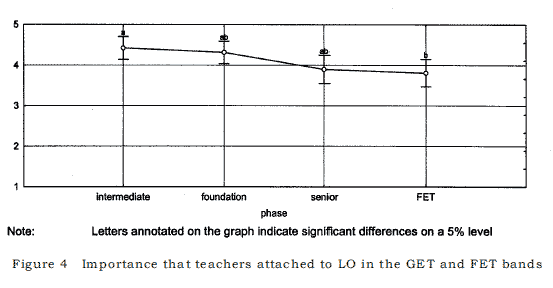
Table 1 depicts the summary statistics as shown in Figure 4 on the importance that LO teachers attached to LO in the different phases of the GET Band as well as in Grades 10 and 11 in the FET Band.
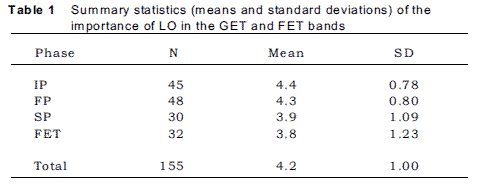
A significant difference (p = 0.02) was found regarding how urban and rural LO teachers rated the importance of LO. Figure 5 indicates that rural LO teachers in all the phases of the GET Band and in Grades 10 and 11 (FET Band) attached more value to LO than their urban counterparts. In urban locations the FP and the IP attached more value to LO than the SP and FET teachers.
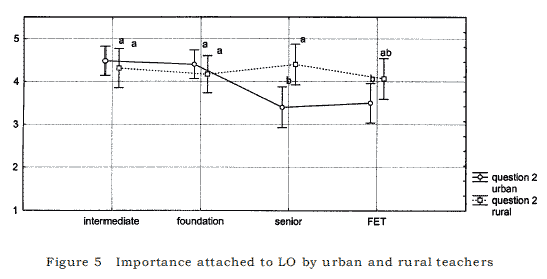
The summary statistics on the importance attached to LO by urban and rural teachers in the different phases of the GET Band as well as in Grades 10 and 11 in the FET Band are shown in Table 2.
In comparing the data between the LO teachers in the FP, IP and SP, as well as the LO teachers in the FET Band regarding whether the Learning Outcome PDM and/or PE was presented as part of LO, no significant difference (p = 0.74) was found. The data indicated that 92% of the LO teachers reported that PDM and/or PE were presented as part of LO in the GET and FET bands, respectively, (Figure 6).
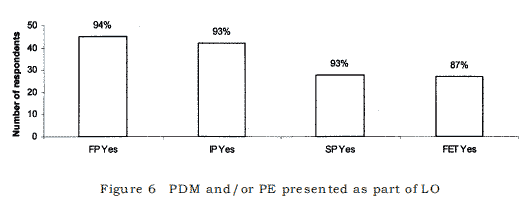
The data indicated that 60% of the LO teachers who facilitated the Learning Outcome, PDM and/or PE in the GET and FET bands, respectively, were not qualified in PE. A comparison of the data between the FP, IP and SP in the GET Band and Grades 10 and 11 show a significant difference (p = 0.00). There was a shortage of LO teachers who were qualified in PE mainly in the FP (Grades R-3), IP (Grades 4-6) and SP (Grades 7-9). The worst scenario was found in the SP where 86% of the LO teachers were not qualified in PE. In the FET Band where 64% of the LO teachers were qualified in PE, the situation appeared better (Figure 7).
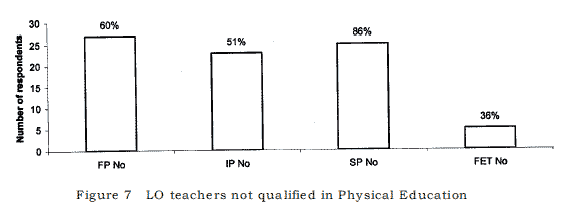
According to the data 97% of the LO teachers reported that integration took place within LO in the GET and FET bands. Regarding integration between LO and other learning areas/subjects in Grades R-11, 93% of the LO teachers reported that it did take place.
The time allocated for the Learning Outcome, PDM and/or PE seemed to be sufficient as 68% of the respondents reacted affirmatively. A significant difference (p = 0.02) was found between the FP, IP, SP and Grades 10 and 11 (FET Band) (Figure 8). In the FP and the IP (primary schools) teachers seemed to feel that the time allocated for the learning outcome on the timetable was sufficient, but in the SP and especially in Grades 10 and 11 (secondary schools) the teachers seemed to differ on this matter.
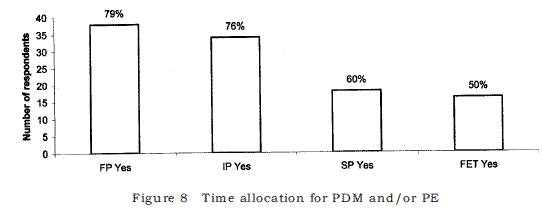
Regarding the assessment of the Learning Outcomes PDM and PE in the GET and FET bands, 58% of the LO teachers reported that they knew how to assess these outcomes. Although no significant difference (p = 0.88) was found between the different phases of the GET and FET Bands, Figure 9 does indicate that LO teachers in the FET Band were to a certain degree uncertain in their response regarding their knowledge about assessment in PE. In the FP, IP and SP of the GET Band more LO teachers indicated that they knew how to apply assessment techniques in PDM.
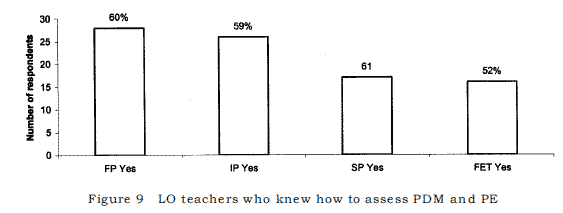
In an attempt to know more about the ability of LO teachers to assess the Learning Outcomes PDM and PE in the GET and FET bands, a question related to the development of learner portfolios, movement rubrics and movement matrixes was included in the questionnaire.
To determine whether the LO teachers knew how to develop learner portfolios, comparisons were drawn between the FP, IP and SP of the GET Band, as well as the FET Band. In this regard 85% of the LO teachers indicated that they did not know how to develop learner portfolios. No significant difference (p = 0.70) was found between the different groups. Figure 10 contains the no responses of the LO teachers for the different phases in the GET and FET Bands.
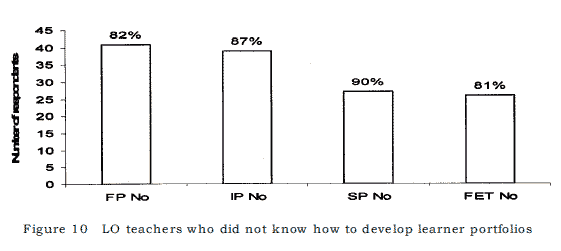
Regarding the development of movement rubrics, 64% of the LO teachers indicated that they did not know how to develop this assessment tool. In a comparison between the phases of the GET Band, and of the FET Band no significant difference (p = 0.42) was found. Figure 11 contains the no responses of the LO teachers for the different phases in the GET and FET bands.
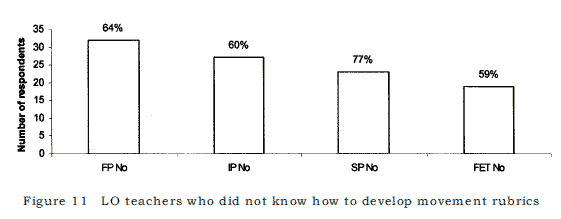
Of the total population, 67% of the LO teachers indicated that they did not know how to develop movement matrixes. No significant difference (p = 0.62) exists between the different phases of the GET Band as well as the FET Band. Figure 12 contains the no responses of the LO teachers for the different phases in the GET and FET bands.
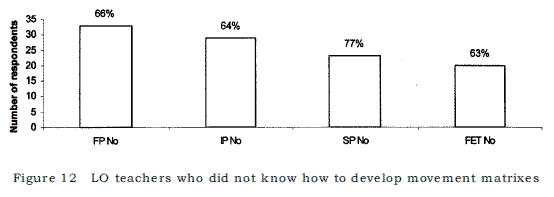
Interest in attending in-service training workshops to learn more about recent developments in LO seemed to be high, as 92% of the LO teachers reacted positively in this regard. No significant difference (p = 0.33) was found between the different phases in the GET Band as well as in the FET Band (Figure 13).
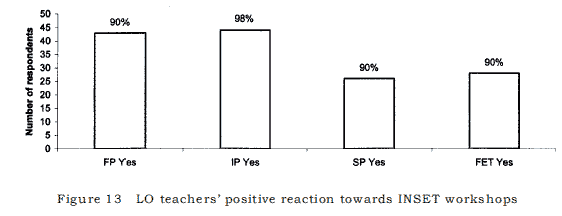
Extra-mural activities and facilities
According to the data most of the LO teachers in the GET and FET Bands reported that facilities and equipment to present PDM and PE, respectively, were a problem. Figure 14 indicates the no responses of the LO teachers regarding available facilities and equipment to teach PDM and PE, respectively.

However, most of the LO teachers in the FP, IP and SP of the GET Band as well as in Grades 10 and 11 indicated, amongst a number of other facilities, that open spaces and halls to present the Learning Outcomes PDM and PE of LO were available. See Figures 15 and 16.
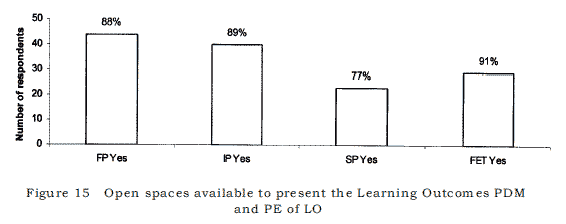

Conclusions
Most of the schools that returned questionnaires served the coloured communities and therefore the findings of this study mostly apply to this category of schools. However, it may be that most of these conclusions could also apply to schools that serve other communities.
It can be concluded that LO as a Learning Area/Subject is currently presented in the majority of schools in the sample and that most LO teachers believe that they understand the principles of OBE. It is clear that the WCED and not HEIs do most of the INSET to equip LO teachers regarding the principles of OBE whether it is structured as short courses or full programmes.
Regarding the importance of LO in general, many teachers rated it as important. However, a comparison between the FP, IP and SP in the GET Band and Grades 10 and 11 shows that LO teachers in the IP rated LO more important than Grade 10 and 11 teachers. A further analysis indicated that SP and FET Band LO teachers in urban schools did not attach the same importance to LO as LO teachers in the FP and IP. In general, rural LO teachers attached more value to LO in the FP, IP and SP of the GET Band and in Grades 10 and 11.
The LO teachers indicated that the Learning Outcome, PDM, was presented in Grades R to 9 in the majority of schools and that the same applies for the Learning Outcome, PE, in Grades 10 and 11. The fact, that most schools did not have qualified LO teachers in PE, held certain implications for LO in general and more specifically for the growth and development of learners. Most of the LO teachers in the FP, IP and SP who presented PDM were not qualified PE teachers. The same tendency regarding generalist teachers teaching LO was found by Van Deventer (2004), Rooth (2005), Christiaans (2006) and Roux et al. (2008). Fortunately, in Grades 10 and 11 more teachers who presented PE were qualified PE teachers. However, the 36% who were not qualified is still a large percentage and should raise concern.
The fact that schools did not have qualified PE teachers in the GET Band impacts negatively on the status and practice of LO. Comments from teachers in the current study like "the children's attitudes are negative and they are not interested"; "A full syllabus does not allow the incumbent teacher sufficient time to do physical training [PE]"; "Unqualified persons find it difficult to implement a programme for assessment"; "Because people are not trained for the movement section it does not come to its right"; "Less focus on LO as a subject"; "LO is given to anyone who fits in on the timetable" is very detrimental for LO as a Learning Area/Subject, but also for education in general. By placing teachers in situations where they lack expertise or find themselves outside their league does not only create stressful situations for the teachers, but raises a number of questions for the learners. They are able to sense the "incompetence" of the teachers and wonder about what value is attached to LO if it is presented by "unqualified" teachers or shifted from one teacher to the next from year to year (Van Deventer & Van Niekerk, 2008:135). The status of LO can only be determined by the epistemology and skills of the teachers who teach it (Rooth, 2005; Christiaans, 2006; Prinsloo, 2007).
Although scientific research on the significance of physical activity "for physical and mental health and many kinds of human well-being" has increased dramatically (Telama, 2002:11), the current situation in South African schools does not enhance the situation to improve the health of our youth. If learners do not or cannot experience the importance of what LO should be, because schools attach little value to it by appointing generalist teachers, how can learners add value to LO and their lives? (Hendricks, 2004; Rooth, 2005; Theron & Denzell, 2006; Prinsloo, 2007). This is in line with Christiaans's (2006) concern that school principals are not sympathetic to the successful implementation of LO.
Rooth (2005) and Prinsloo ( 2007) believe that it is unrealistic to expect thoroughly trained and experienced LO teachers in all schools because it is a new Learning Area/Subject within a curriculum in rapid transition. I could not disagree more with this statement. It is not educationally sound to implement a new learning area/subject without having the necessary human resources to present it. In the long run only education in general and more specifically the learners suffer as a consequence of such a decision by the authorities who have the responsibility to provide quality education that is holistic and looks after the best interests of the learners it serves.
According to the NCS, 33% of the total time of LO in the IP and 30% in the SP, which boils down to approximately 40 minutes per week, is set aside for PDM in the GET Band and 60 minutes per week for PE in the FET Band (DoE, 2003b; DoE, 2008a). Regarding the time allocation for PDM and PE in general within the framework of LO, it seemed as if most schools felt that the time allocation was sufficient. However, Rooth (2005) warns that precise time allocation is not a straightforward factor to ascertain due to the diffuse definitions and understanding of what constitutes LO amongst LO teachers. From some of the comments made by LO teachers in the current study it could be deduced that PE was viewed as something separate from LO which adds to the confusion regarding sufficient time allocation for LO. The misconception regarding sufficient time on the school timetable for PDM and PE in the current study can further be ascribed to the fact that the LO teachers are not knowledgeable regarding the subject matter of PE.
Although most schools did not have LO teachers that were qualified in PE, a number of LO teachers reported that they knew how to assess the Learning Outcomes PDM and PE of LO, respectively. This finding is contrary to the finding that most LO teachers in the GET and FET bands were not knowledgeable about the content of PE. It is doubtful whether these LO teachers are knowledgeable enough to be able to assess the subject matter of PE. However, a further analysis indicated that most of the LO teachers do need assistance in developing learner portfolios, movement rubrics and movement matrixes which again confirms the necessity of having specifically trained teachers for specific learning areas/subjects. As was stated earlier it is issues like these that do tremendous harm to a learning area's/subject's status and to education in general.
Most of the LO teachers in the GET Band and in Grades 10 and 11 reported that they did not have sufficient facilities and equipment to present PE, Sport and Recreation. However, to a certain degree, the LO teachers did indicate that they had the necessary facilities to present PE, Sport and Recreation. Van Deventer (1999) reported similar results.
A conclusion that is in line with all the above arguments regarding the urgent need for properly qualified LO teachers can be drawn from the fact that the majority of the LO teachers indicated that they need INSET workshops related to recent developments in LO. As far back as 2001, Welton (2001) purported that there seems to be a massive need amongst teachers for knowledge, skills and understanding to handle all the pressures and to manage change. For most of the LO teachers in the current survey, notwithstanding the fact that they had to manage change, they also needed to manage an unfamiliar environment with unfamiliar tools (i.e. the Learning Outcomes, PDM and PE, of LO). Although INSET is only a short-term solution, it is at least a starting point.
Recommendations
If LO is regarded as an important Learning Area/Subject in the NCS, as postulated by the DoE (DoE, 2002b), Hendricks (2004), Rooth (2005), Theron and Dalzell (2006), Van der Walt and De Klerk (2006), and Prinsloo (2007), action needs to be taken to address the current situation surrounding LO.
The following recommendations are presented:
o The major problem reported by the LO teachers is that they are not qualified to teach all the learning outcomes of LO. To alleviate the immediate need, LO teachers should undergo INSET to enable them to present not only the Learning Outcomes PDM and PE, respectively, but to be able to teach LO as it should be taught as an integrated whole. This situation should receive immediate attention by the DoE and HEIs. In-service education and training can be in the form of an Advanced Certificate in Education (ACE) running over a period of one or two years or it can be in the form of short courses structured over a specific period of time depending on the nature of the content to be covered.
o Another way to alleviate immediate needs could be to cluster schools that are situated close to each other within a specific region. These schools could then share resources (e.g. sports facilities and equipment and human resources), or a qualified PE teacher could be appointed to teach LO at this cluster of schools. This is not something new. The DoE refers to this concept as multipurpose cluster facilities (DoE, 2000b). In 2000 one of the priorities of Sport and Recreation South Africa was to establish multi-purpose sports facilities in disadvantaged communities (DSR, 2000).
o A more aggressive approach for pre-service education and training (PRESET) of LO teachers should be launched immediately by HEIs to ensure that the backlog of teachers, due to transformation in education, teacher- learner ratios and the elimination of non-examinable subjects, is erased. It is known that many HEIs in SA do not present an education component with the Sport Science degree and these institutions do not link a Postgraduate Certificate in Education (PGCE) to their Sport Science programmes.
o Higher Education Institutions should become more involved in INSET as part of their community interaction strategy. Postgraduate students could be used in INSET by making service-learning a credit-bearing component of their programme. Schools in which the service-learning takes place can be adopted' by HEIs.
o Regarding the PRESET of prospective teachers, universities should be more flexible regarding the programmes that they design and present. In certain instances programmes at universities are so fixed in their structure that it is impossible for students to select the necessary modules at graduate level in order to present at least two school subjects in the PGCE. In certain instances students who really want to teach are kept out of the profession due to this reason.
o Regarding PRESET in the BEd degree an insufficient amount of time in the four-year programme is devoted to the movement component of LO. These students study to become teachers in the GET Band and most of them are not movement orientated. It therefore takes more time to teach these students the different movement forms to enable them to teach the movement outcome of LO.
o To have a real impact, more time per week should be allocated to the Learning Outcome, PDM. Only then will learners be able to realise the benefits associated with regular exercise.
o The DoE should also be part of the solution. In 1997, Burnett purported that SA urgently needs a clear-cut policy on PE and school sport (PESS), the provision of much needed infrastructure and an effective and efficient delivery system and qualified PE specialists (Burnett, 1997). Since 1995 a number of initiatives have been launched to ensure that PESS has a place in South Africa's education system. This culminated in a collaborative effort in 2000 to develop a policy for PESS by an Interdepartmental Task Team (IDTT) for which the DoE was responsible (IDTT, 2000; Van Deventer, 2002). With the publication of the Review Committee's report on C2005 on 31 May 2000 the work of the IDTT was abruptly terminated (Van Deventer, 2002).
Since then a number of documents regarding PESS have been drafted and a number of articles have appeared in newspapers countrywide. In the 2007 budget speech the South African Deputy Minister of Sport and Recreation made a number of important statements regarding PESS in particular. On the one hand, the Deputy Minister purports that he is worried about the damage that has been caused by the demise of PE in South African schools, that school sport must be massified and coached by teachers who are trained to provide quality coaching. The Deputy Minister states that "Physical Education as a subject is high on the agenda of the DoE" (Oosthuizen, 2007:5).
In the light of these and previous statements by the South African government, the main question that remains unanswered is when this paper game will come to an end so that the disparities of the past can be equalised. We need to remember that the impact of OBE cannot be equal in unequal conditions (Jansen, 1999; Botha, 2002; Fiske & Ladd, 2004; Prinsloo, 2007).It should also be remembered that lifestyle changes prevalent in modern society require paradigm shifts in attitudes, through processes and approaches to bring about an awareness of quality of life and total wellness. This does not occur overnight. Changes in lifestyle patterns do not involve fairies and magic wands, but hard, persistent work from dedicated teachers in experiential learning environments that are qualified to do the job. Higher Education Institutions have a major role to play in this regard by producing quality teachers motivated to provide such a service to South African schools (Van Deventer & Van Niekerk, 2008). We are in agreement with a statement of Hardman (2003:30) that we can:
accept the situation for what it is and suffer the consequences; the other is to confront the situations and address available options ...
Acknowledement
I acknowledge the contributions of Ms E van Niekerk towards this research.
References
Botha RJ 2002. Outcomes-based education and educational reform in South Africa. International Journal of Leadership in Education, 5:361-371. [ Links ]
Burnett C 1997. Can sport and recreation address the manifestation of poverty in the South African context? African Journal for Physical, Health Education, recreation and Dance (AJPHERD), 3:83-107. [ Links ]
Christiaans DJ 2006. Empowering teachers to implement the Life Orientation learning area in the Senior Phase of the General Education and Training Band. Unpublished MEd dissertation. Stellenbosch: Stellenbosch University. [ Links ]
Department of Education (DoE) 1997. Curriculum 2005. Pretoria: Department of Education. [ Links ]
Department of Education (DoE) 2000a. Report of the review committee on Curriculum 2005. A South African Curriculum for the 21st Century. Pretoria: Department of Education. [ Links ]
Department of Education (DoE) 2000b. Ministerial briefing guidelines on policy on human movement and school sport — draft 3, May 2000. Pretoria: Department of Education. [ Links ]
Department of Education (DoE) 2002a. Revised National Curriculum Statement Grades R-9 (Schools). Overview. Pretoria: Department of Education. [ Links ]
Department of Education (DoE) 2002b. Revised National Curriculum Statement Grades R-9 (Schools). Life Orientation. Pretoria: Department of Education. [ Links ]
Department of Education (DoE) 2003a. National Curriculum Statement Grades 10-12 (General). Life Orientation. Pretoria: Department of Education. [ Links ]
Department of Education (DoE) 2003b. Revised National Curriculum Statement Grades R-9 (Schools). Teacher's guide for the development of learning programmes policy guidelines. Life Orientation. Pretoria: Department of Education. [ Links ]
Department of Education (DoE) 2008a. National Curriculum Statement Grades 10-12 (General). Subject assessment guidelines: Life Orientation. Pretoria: Department of Education. [ Links ]
Department of Education (DoE) 2008b. National Curriculum Statement Grades 10-12 (General). Learning programme guidelines: Life Orientation. Pretoria: Department of Education. [ Links ]
Department of Sport and Recreation (DSR) 2000. White-paper: Department of Sport and Recreation. Available at [http://www.policy.org.za/govdocs/white_paper/sportswp.htm]. [ Links ]
Fiske EB & Ladd H 2004. Equity. Education reform in post-apartheid South Africa. Washington: Brookings Institution Press. [ Links ]
Hardman K 2003. The state and status of physical education in schools: Foundation for deconstruction and reconstruction of physical education. In: K Hardman (ed.). Physical education: Deconstruction and reconstruction — Issues and directions (15-34). [ Links ]Sport Science Studies, 12. Berlin: International Council of Sport Science and Physical Education. [ Links ]
Harley K & Wedekind V 2004. Political change, curriculum change and social formation, 1990 to 2002. In: L Chisholm (ed.). Changing class, education and social change in post-apartheid South Africa. London: Zed Books. [ Links ]
Hendricks PC 2004. The role of physical education in South African primary schools. Unpublished MEd dissertation. Cape Town: University of the Western Cape. [ Links ]
Interdepartmental Task Team (IDTT) 2000. Draft agenda of the meeting of the Interdepartmental Task Team on policy for physical education/human movement and school sport, 15-16 March, Pretoria. Pretoria: Department of Education. [ Links ]
Jansen JD 1998. Curriculum reform in South Africa: A critical analysis of outcomes-based education. Cambridge Journal of Education, 28:321-331. [ Links ]
Jansen JD 1999. Globalisation, curriculum and the Third World State: In dialogue with Michael Apple. Current Issues in Comparative Education, 1:42-47. [ Links ]
Manganyi NC 2001. Public policy and the transformation of education in South Africa. In: Y Sayed & J Jansen (eds). Implementing education policy. The South African experience. Cape Town: UCT Press. [ Links ]
Mathieson S 2001. The role of the ANC Education Study Group in the legislative and policy process. In: Y Sayed & J Jansen (eds). Implementing education policy. The South African experience. Cape Town: UCT Press. [ Links ]
Oosthuizen GC 2007. Budget speech of Deputy Minister Gert C Oosthuizen, MP, 22 May 2007. Pretoria: Department of Sport and Recreation South Africa. [ Links ]
Prinsloo E 2007. Implementation of life orientation programmes in the new curriculum in South African schools: perceptions of principals and life orientation teachers. South African Journal of Education, 27:155-170. [ Links ]
Rooth E 2005. An investigation of the status and practice of Life Orientation in South African schools. Unpublished PhD thesis. Cape Town: University of the Western Cape. [ Links ]
Roux CJ, Burnett C & Hollander WJ 2008. Curriculum enrichment through indigenous Zulu games. South African Journal for Research in Sport, Physical Education and Recreation, 30:89-103. [ Links ]
STATSOFT 2007. Statistica for Windows: General conventions and statistics. Tilsa, OK: Statsoft. [ Links ]
Talbot M 2001. The case for physical education. In: G Doll-Tepper & D Scoretz (eds). Proceedings of the world summit on physical education. Berlin, November 3-5, 1999. Schorndorf: Verlag Karl Hofmann Schorndorf. [ Links ]
Telama R 2002. ICSSPE and initiatives for physical education. International Council of Sport Science and Physical Education Bulletin, 34:10-12. [ Links ]
Theron L & Dalzell C 2006. The specific Life Orientation needs of Grade 9 Learners in the Vaal Triangle region. South African Journal of Education, 26:397-412. [ Links ]
Todd A & Mason M 2005. Enhancing learning in South African schools: strategies beyond outcomes-based education. International Journal of Educational Development, 25:221-235. [ Links ]
Vambe MT 2005. Opening and transforming South African education. Open Learning, 20:285-293. [ Links ]
Van der Walt JL & De Klerk J 2006. Die effektiwiteit van die Lewensoriënteringsprogram volgens 'n groep Suid-Afrikaanse onderwysers — ruimte vir verbetering? Tydskrif vir Christelike Wetenskap, 42:175-193. [ Links ]
Van Deventer KJ 1999. Physical education and sport in selected Western Cape High schools. Unpublished research report. Stellenbosch: Department of Sport Science, Stellenbosch University. [ Links ]
Van Deventer KJ 2002. Quality physical education and the partnership concept. South African Journal for Research in Sport, Physical Education and recreation, 24:101-119. [ Links ]
Van Deventer KJ 2004. A case for physical education/Life Orientation: the health of a nation. South African Journal for Research in Sport, Physical Education and recreation, 26:107-121. [ Links ]
Van Deventer KJ 2007. A paradigm shift in Life Orientation: A review. South African Journal for Research in Sport, Physical Education and recreation, 29:131-146. [ Links ]
Van Deventer KJ & Van Niekerk E 2008. Life Orientation in grades R-11: Teachers' perspectives on the implementation of Life Orientation in selected Western Cape Schools. Unpublished research report. Stellenbosch: Stellenbosch University. [ Links ]
Welton J 2001. Building capacity to deliver education in South Africa? In: Y Sayed & J Jansen (eds). Implementing education policy. The South African experience. Cape Town: UCT Press. [ Links ]
Whitaker T & Whitaker B 1995. Outcomes-based education: The need, the critics, the movement forward. The struggle to ensure learning. Contemporary Education, 66:248-250. [ Links ]














